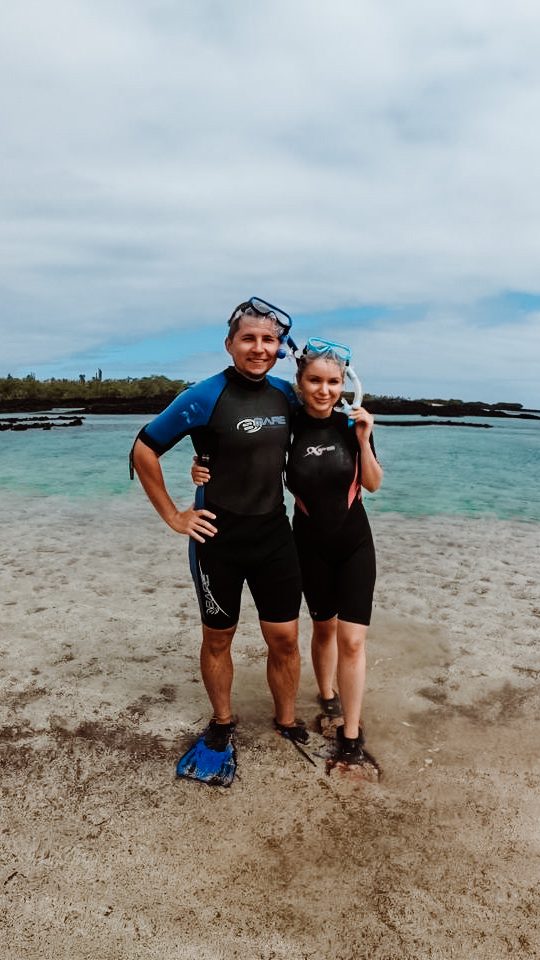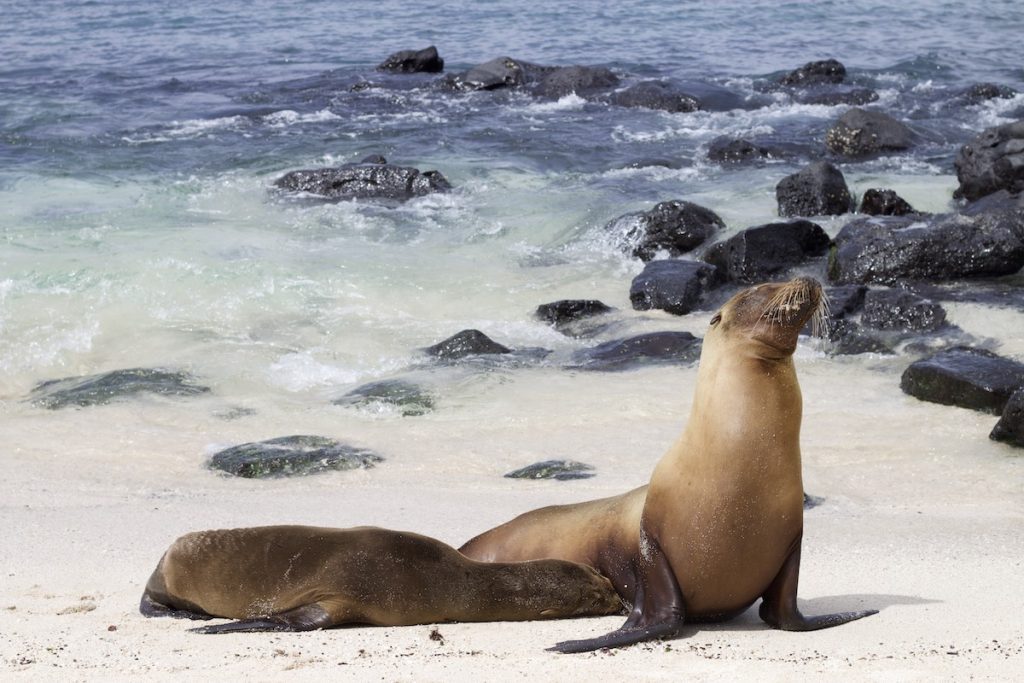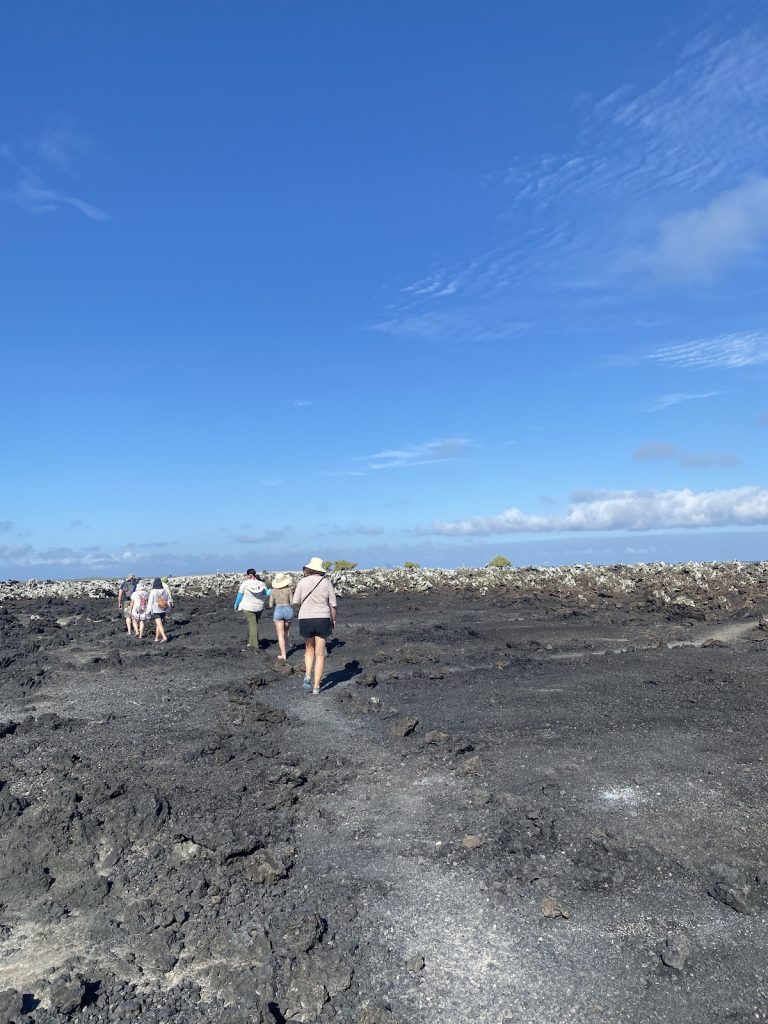Pitt Point, commonly known as Punta Pitt, is located on the extreme eastern borders of San Cristobal Island. The cheerful and loud barking of the local Galápagos Sea Lion population will greet you after a wet landing right on the beach! This is a bachelor colony of males that haven’t established a breeding territory, and they can be a touch rough around the edges if they’ve been fighting on one of the nearby mating beaches.
Following the commotion of the beach, we follow a calmer road up the cliffs to a nesting spot utilized by all three local species of booby, the Blue-Footed, Red-Footed, and Nazca Boobies. Nowhere else in the Galapagos Islands do all three species nest together like this.
In addition to this unusual booby colony, you may view Galápagos Frigatebirds and petrels. Aside from the amazing bird life, the vista down to the beach and across the island from this high vantage point is worth the trek.
The hiking route allows you to get up and personal with the Saltbush and other resistant bushes that persist in this often scary volcanic terrain.
We passed by Punta Pitt during a 360 tour on San Cristobal Island:
Looking back, visiting Punta Pitt required careful planning – from choosing the right tour to timing our visit for optimal booby sightings. Skip the uncertainty I faced and get a FREE personalized Galapagos trip quote from my trusted local experts who know exactly when to experience this unique spot where all three booby species nest together. Your booking helps support both this blog and local Galapagos communities.
Table of Contents
Plan perfect trip to Ecuador & Galapagos
I spent countless hours researching everything about traveling to Ecuador, and I created this blog for fellow travel enthusiasts who want the best, most reliable information. But if you want to save time, we’ve partnered with the top local agency to plan your dream trip.
How to Get to Punta Pitt
To go to Punta Pitt, you must book guided tours with local tour companies.
Wildlife in Punta Pitt
Some of the interesting wildlife you’ll see in Punta Pitt are:
- Blue-footed boobies
- Nazca boobies
- Red-footed boobies
- Frigates
- Pelicans
- Darwin finches
- San Cristobal cucuves
- Sea lions
- Seagulls
- Sea turtles
- Rays
- Tropical fish
Our Punta Pitt Experience
We set sail from Puerto Baquerizo Moreno to explore the northwest side of San Cristobal Island. Our first stop was at Pitt Islet, where we geared up for our first snorkel of the day. We then hopped on a panga to Pitt Point for a second snorkeling session. After a few days in the Galapagos, snorkeling had become a regular part of our routine, yet the thrill never faded—each island offers something new to discover.
We continued onward to Punta Pitt, where a scenic trail led us to a natural lookout point. The landscapes were impressive, and we had the chance to see all three species of boobies: the Nazca, the blue-footed, and the rare red-footed boobies, the least common species in the archipelago.
Watching the boobies, known as “piqueros” in Spanish due to their diving style, was fascinating. They fuel up by plunging into the ocean for fish, showing impressive speed in flight, but on land, they appear clumsy—a trait that earned them the English name “boobies,” derived from the Spanish “bobo,” meaning “silly.”
After taking in the stunning views and observing the birds, we enjoyed a delicious lunch on the boat before making our way back to Puerto Baquerizo Moreno.
Trust me, while Punta Pitt is amazing, knowing how to combine it with other San Cristobal highlights makes the experience even better! Want an expertly planned itinerary that balances hiking, snorkeling, and wildlife viewing? Get a FREE quote from my recommended local agency. Your booking supports this blog and local Galapagos businesses.
When to Visit Punta Pitt
Punta Pitt is stunning year-round, though peak tourist seasons are typically between mid-December to mid-January and again from mid-June to September. For those interested in surfing at Punta Pitt Point, the ideal months are June and December, when the waves are consistently clean, offering good swells with gentle or offshore breezes.
In December, you can expect clean, surfable waves around 27% of the time, although conditions are blown out around 15% of the time due to wind.

Planning trip to Galapagos Islands?
My wife and I spent two weeks on these magnificent islands, visited nearly every possible tour, and explored as much as we could. I shared all the important details in my comprehensive Galapagos Islands Travel Guide, where I cover everything you need to know about planning a trip to the Galapagos.
Galapagos Islands travel might surprise you with extra fees to enter the islands, the complicated logistics between islands, booking tours, and knowing which spots are free to explore and which ones are not. I’ve covered it all in this Galapagos Travel Guide.
Also, if you’re planning a trip to the Galapagos, make sure to use my link for discounted hotel prices via Booking.com. It really helps support my blog!
Bottom Line
Punta Pitt is a must-do day tour on San Cristobal Island, Galapagos. With opportunities for hiking, snorkeling, and soaking in the incredible scenery and unique wildlife, it’s an experience that truly showcases the beauty of the islands. Be sure to add Punta Pitt to your Galapagos bucket list for an unforgettable adventure!
Plan perfect trip to Ecuador & Galapagos
I spent countless hours researching everything about traveling to Ecuador, and I created this blog for fellow travel enthusiasts who want the best, most reliable information. But if you want to save time, we’ve partnered with the top local agency to plan your dream trip.






